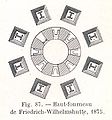Friedrich Wilhelms-Hütte
| Friedrich Wilhelms-Hütte
|
|
|---|---|
| legal form | GmbH |
| founding | 1848 |
| Seat | Mülheim an der Ruhr |
| Number of employees | 440 (2020) |
| sales | EUR 109.9 million (FY 2008) |
| Branch | steel |
| Website | www.fwh.de |

The Friedrich Wilhelms-Hütte is a steel casting factory based in Mülheim an der Ruhr . For the first time in the Ruhr area , pig iron was produced here in 1849 in a blast furnace that was charged with coke . The company was part of the Thyssen Group until 1998 and has belonged to Georgsmarienhütte Holding GmbH since the merger of Thyssen and Krupp . The turnover in 2005 was over € 68 million.
In the area of cast steel and iron, cylinder blocks , housings for gas and steam turbines and rotor hubs for wind turbines are manufactured.
history
In the fall of 1811 Johann Dinnendahl set up a mechanical workshop in Mülheim on the right bank of the Ruhr. After initially producing steam engines , he and his brother Franz Dinnendahl founded an iron smelter in 1820 for the production of cast machine parts . Together with the Ruhrort businessman Friedrich Wilhelm Liebrecht as a financially strong partner, he applied for a license for two blast furnaces with coke operation in 1832. One of them was supposed to be built next to the iron smelter in Mülheim and was named Friedrich Wilhelms-Hütte based on Liebrecht's first name. It was not until 1848/1849 that pig iron production could begin in the modern coke oven. After Dinnendahl's death, the company was converted into the "Bergwerks-Verein Friedrich Wilhelms-Hütte AG" in 1852. In 1862 the hut was expanded to include a pipe foundry. In 1905 Hugo Stinnes joined the company of the German-Luxemburgish Mining and Hütten-AG (DL) and became its chairman. In 1907 the steel foundry was put into operation. In 1926, the mining division of DL was incorporated into Vereinigte Stahlwerke AG (VSt). In 1933, with the works of the Friedrich Wilhelms-Hütte, the Schalker Verein , the ironworks in Meiderich and the foundry in Hilden, the Deutsche Eisenwerke AG was founded as VSt's own operating company.
After the Second World War, Friedrich Wilhelms-Hütte and Hütte Meiderich were merged in 1948 in the course of the demerger of Vereinigte Stahlwerke AG into Eisenwerke Mülheim / Meiderich AG with 4626 (in 1947) and 6969 (in 1951) workers. In 1963 it was taken over by Rheinstahl and merged with Eisenwerke Gelsenkirchen and Ruhrstahl to form Rheinstahl Hüttenwerke AG .
In the 1960s, restructuring and the decline of the coal and steel industry in the Ruhr area led to the closure of the blast furnace, the cement works and the hand-molded steel foundry. After the Rheinstahl concern was taken over by “August Thyssen-Hütte AG”, FWH was renamed “Thyssen Gießerei AG, Friedrich Wilhelms-Hütte” plant in 1976. Friedrich Wilhelms-Hütte GmbH was acquired by Georgsmarienhütte Holding GmbH in 2001 and became an independent company in its casting division . In 2006 the Friedrich Wilhelms-Hütte GmbH became the two companies “Friedrich Wilhelms-Hütte Eisenguss GmbH” and “Friedrich Wilhelms-Hütte Stahlguss GmbH”.
Today the hut is part of the Route of Industrial Culture (Theme Route 11 - Early Industrialization and Theme Route 12 - History and Present of the Ruhr ).
Pictures of the hut
Drawings of the blast furnace from 1875
Individual evidence
- ↑ top v .: "Unbundling of the steel industry" in: "Hüttenzeitung" of the Bochumer Verein, JG 22/23, 1951
- ↑ Georgsmarienhütte website on the history of the FWH site online (accessed on July 26, 2010)
Web links
- Website of the Friedrich Wilhelms-Hütte
- Photo documentation of the FWH
- Description of all locations on this themed route as part of the Route of Industrial Culture
Coordinates: 51 ° 26 ′ 10.9 ″ N , 6 ° 52 ′ 21 ″ E














